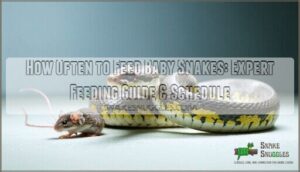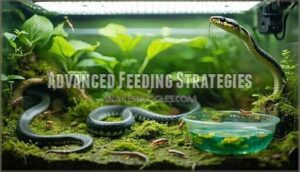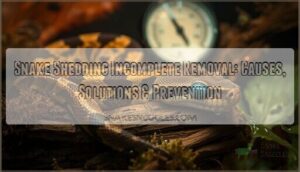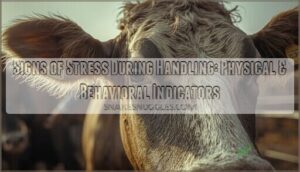This site is supported by our readers. We may earn a commission, at no cost to you, if you purchase through links.

Fast-growing species like ball pythons and corn snakes often need feeding every 5-6 days during their first few months. Choose prey that’s roughly the same width as the thickest part of your snake’s body—typically pinkie mice for most hatchlings.
Unlike adults who can fast for weeks, babies are growth machines requiring consistent nutrition. You’re doing it right when your snake maintains steady weight gain and enthusiastically accepts meals.
Getting the timing wrong can mean stunted growth or digestive stress, but there’s more than just frequency to take into account.
Table Of Contents
- Key Takeaways
- Snake Feeding Basics
- How Often Feed Baby Snakes
- Factors Affecting Frequency
- Feeding Techniques and Tips
- Monitoring Snake Health
- Feeding Schedules and Adjustments
- Advanced Feeding Strategies
- Frequently Asked Questions (FAQs)
- How do I tell if my baby snake is hungry?
- How often should you handle a baby corn snake?
- How often should a baby snake eat?
- Can baby snakes eat at the same time?
- How often should you feed a baby corn snake?
- How often should you feed a king snake?
- How Can You Tell the Age of a Baby Snake?
- What Temperatures Do Baby Snakes Need to Thrive?
- How Do Wild Baby Snakes Find Food and Water on Their Own?
- What Health Problems Are Common in Baby Pet Snakes?
- Conclusion
Key Takeaways
- Feed your baby snake every 5-7 days – Hatchlings need consistent nutrition for rapid growth, with fast-growing species like ball pythons and corn snakes requiring food every 5-6 days during their first few months.
- Choose prey that matches your snake’s body width – Select food roughly the same diameter as the thickest part of your snake’s body, typically starting with pinkie mice for most hatchlings to prevent regurgitation or stunted growth.
- Monitor weight and feeding responses weekly – Track your snake’s weight gain and watch for hunger cues like increased activity and tongue-flicking to adjust feeding schedules and ensure healthy development.
- Adjust frequency as they grow – Extend feeding intervals from every 5-7 days for hatchlings to 7-10 days for juveniles, then 10-14 days for subadults as their metabolism slows with age.
Snake Feeding Basics
Feeding baby snakes correctly sets the foundation for their healthy development and long-term well-being.
You’ll need to understand three core principles: choosing appropriately sized prey, ensuring proper nutrition quality, and creating a safe feeding environment, which are essential for their development.
Importance of Prey Size
Choosing proper prey size determines your baby snake’s feeding success and health.
Right-sized prey means healthy snakes – too big risks regurgitation, too small stunts growth.
Prey that’s too large causes regurgitation risks, while undersized food won’t meet nutritional needs for ideal growth.
- A fuzzy mouse that’s 1.5 times your snake’s thickest body section
- Prey creating a visible bulge without stretching the snake uncomfortably
- Food progression from pinkies to fuzzies as your snake grows
Correct sizing promotes digestion efficiency and supports steady size progression in your newborn snake diet plan.
Always aim for prey that matches the snake’s widest body diameter, ensuring proper feeding and healthy growth.
Prey Quality and Nutrition
Quality matters more than quantity when feeding your baby snake.
Frozen prey offers consistent nutrition and eliminates disease risks common with live options.
Gut loading feeder mice with nutritious foods boosts their value.
Prey variety prevents nutritional deficiencies – rotate between mice, rats, and appropriate alternatives.
Supplementation needs vary by species, but high-quality frozen prey typically provides complete newborn snake diet requirements for ideal growth and is a good source of frozen prey.
Feeding Environment and Safety
Creating a secure feeding environment protects both you and your baby snake.
Clean your hands before handling prey, and use feeding tongs to maintain safe distance during snake feeding.
Control humidity and temperature in the enclosure to support digestion. Remove uneaten food promptly to prevent bacterial growth.
Proper snake handling techniques and feeding hygiene guarantee your young snake stays healthy while establishing a consistent snake feeding schedule. This is crucial for the snake’s overall health, and proper snake handling is key to preventing accidents and ensuring a safe environment.
How Often Feed Baby Snakes
Baby snakes need consistent nutrition to support their rapid development, but timing matters more than you might think.
Timing your baby snake’s meals right can make the difference between thriving and just surviving.
Most hatchlings require feeding every 5-7 days, though this varies by species and individual growth rates. Your snake’s age, size, and metabolism all influence their feeding frequency, making careful observation essential for proper baby snake care.
Here’s your essential baby snake feeding schedule:
- Hatchling corn snakes: Feed every 5-6 days for ideal growth
- Ball python babies: Offer food every 5-7 days, adjusting as they mature
- First feeding: Wait 5-7 days after hatching, once first shed completes
- Overfeeding warning: Too frequent meals cause regurgitation and digestive issues
- Growth monitoring: Track weight weekly to guarantee steady, healthy increases
Understanding feeding cycles helps you establish routines that support snake nutrition needs without overwhelming their developing digestive systems. Regular feeding frequency creates predictable patterns that benefit both you and your growing snake.
Factors Affecting Frequency
Your baby snake’s feeding schedule depends on several key factors that you’ll need to take into account.
Snake age, size, metabolism, and activity level all play vital roles in determining how often your young serpent needs to eat, considering its metabolism.
Snake Age and Growth
Your snake’s age directly impacts its feeding schedule.
Hatchlings need meals every 5-7 days for rapid growth rates, doubling their weight in three months.
Growth rates slow as snakes approach maturity stages around 2-4 years.
Young snakes require frequent feeding for proper development, while adults can wait longer between meals.
Snake Size and Metabolism
Beyond age, your snake’s size directly impacts its Metabolic Rates and Energy Needs.
Smaller snakes burn energy faster, requiring more frequent meals than their larger counterparts.
This size-metabolism relationship determines ideal Feeding Frequency for healthy Snake Growth.
- Snakes under 50g typically need feeding every 5-7 days
- Larger juveniles can extend to 7-10 day intervals
- Scale Patterns become more defined with proper nutrition timing
Snake Activity Level and Hunger
Activity levels directly influence how often you’ll notice Hunger Cues and Feeding Triggers in your baby snake.
Active species show clear Hunger Signals through increased movement and tongue-flicking, while ambush predators may seem less obvious.
Understanding your snake’s Activity Patterns helps you recognize when feeding young snakes becomes necessary.
The feeding schedule is also influenced by the snake’s metabolism rate.
| Activity Level | Hunger Cues | Feeding Frequency | Metabolism Impact |
|---|---|---|---|
| High Activity | Frequent exploration, active hunting behaviors | Every 5-7 days | Faster Snake Metabolism, quicker digestion |
| Moderate Activity | Occasional movement, responsive to stimuli | Every 7-10 days | Balanced energy needs |
| Low Activity | Minimal movement, longer rest periods | Every 10-14 days | Slower processing, extended fasting tolerance |
| Ambush Style | Subtle positioning changes, alert posture | Every 7-14 days | Efficient energy conservation |
Feeding Techniques and Tips
Proper feeding techniques guarantee your baby snake accepts prey safely and develops healthy eating habits.
You’ll need the right tools and timing to create positive feeding experiences that support your snake’s growth and well-being.
Using Feeding Tongs and Tools
Using proper tools keeps you safe and protects your snake during feeding.
Quality Feeding Tongs or Snake Tongs with rubber-tipped ends prevent accidental bites while offering prey to feeding young snakes.
Feeding Forceps work well for smaller meals, while Feeding Pliers handle larger prey items effectively.
Always practice Tool Sanitation between feedings—clean with reptile-safe disinfectant to prevent bacteria transfer.
Proper Tong Handling means gripping prey securely without crushing it, maintaining steady movements that won’t startle your snake during this critical feeding process.
Effective snake feeding requires using the right snake feeding tools to guarantee a safe and healthy feeding experience.
Offering Prey During Active Hours
Timing matters when feeding baby snakes.
Most species are naturally active during evening hours, making this the ideal window for offering prey.
Watch for feeding cues like tongue flicking and increased movement – these signals indicate your snake’s ready to eat.
Daytime feeding often results in rejected meals since juvenile snakes follow instinctual patterns, so patience pays off.
Understanding proper snake feeding techniques is essential for a healthy feeding routine, and recognizing the importance of timing is crucial.
Monitoring Snake Reactions and Behavior
Watch for three key behavior patterns when feeding your snakelets. A hungry snake body will actively explore its habitat, tongue-flicking frequently to detect prey scents.
Post-feeding, healthy snakes retreat to digest, showing reduced activity for days. Monitor feeding cues like searching behavior and reaction times to prey presentation, adjusting your snake feeding guide accordingly.
Proper handling with snake feeding tongs requires understanding safe handling techniques to minimize stress on the animal, using safe handling techniques and observing key behavior patterns to ensure the snake’s well-being, including reduced activity and proper handling.
Monitoring Snake Health
Keeping tabs on your baby snake’s health guarantees proper growth and catches potential issues early.
You’ll want to track three key areas: weight changes, activity patterns, and environmental conditions like water and humidity levels.
Tracking Weight Changes and Growth
Regular weight tracking reveals your baby snake’s growth patterns and helps adjust feeding schedules accordingly.
Weigh your snake weekly using a digital scale, recording measurements in feeding charts to monitor snake development over time.
Healthy growth rates vary by species, but consistent weight gain indicates proper nutrition.
These records become invaluable references for determining how often to feed snakes as they mature from snakelets to juveniles.
Observing Activity Levels and Hunger Cues
Active baby snakes display increased movement, tongue-flicking, and exploration when hungry.
You’ll notice restless behavior, prowling along glass, and heightened responses to movement.
Healthy snakes maintain consistent activity patterns between feedings.
Lethargic behavior or excessive hiding may indicate overfeeding, illness, or stress.
Monitor these feeding triggers to establish proper reptile feeding frequency for ideal growth rates.
Understanding proper snake health checks is essential for identifying potential issues early on, which is crucial for maintaining snake health.
Providing Fresh Water and Humidity
Beyond proper feeding schedules, fresh water and ideal humidity levels form the foundation of baby snake health.
You’ll need clean water bowls that allow easy access without drowning risk.
Maintain species-appropriate humidity through misting systems or substrate moisture.
Poor water quality affects snake hydration, while incorrect humidity impacts shedding and respiratory health, making these environmental factors just as vital as understanding what baby snakes eat, including the importance of fresh water, ideal humidity, and respiratory health.
Feeding Schedules and Adjustments
Creating a feeding schedule helps you track your snake’s growth and guarantees consistent nutrition throughout their development.
You’ll need to adjust feeding frequency as your baby snake grows, monitoring their health and body condition to make necessary changes along the way, ensuring proper care for your pet.
Tracking Feeding Frequency and Amount
Maintaining detailed feeding charts helps you track your snake’s growth patterns and establish consistent meal schedules.
Record dates, prey sizes, and your snake’s weight to identify ideal food intake amounts.
Monitor hunger signs like increased activity or tongue-flicking to determine how often to feed snakes effectively.
Document what baby snakes eat and adjust portions accordingly for healthy development to ensure you are providing the best care for your snake’s growth patterns.
Adjusting Schedules Based on Snake Age
As your snake progresses through Development Stages, you’ll need to adjust how often to feed snakes accordingly.
Hatchling Care requires feeding every 5-7 days, while juvenile snake diet shifts to 7-10 day intervals.
Age Factors determine when to extend Feeding Cycles – subadults need food every 10-14 days, and adults require feeding only every 2-4 weeks.
Monitor Snake Growth closely during these phases to confirm proper small snake feeding schedules.
Monitoring Snake Health and Adjusting
Watch your baby snake’s behavior patterns closely to spot health issues early.
Sluggish movement, irregular shedding, or refusing food signals potential problems requiring immediate feeding adjustments.
Consistent growth rates and healthy snake behavior indicate proper snake nutrition.
Keep detailed feeding charts to track what do baby snakes eat and when, adjusting juvenile snake diet frequency based on health checks and individual growth responses.
The key to successful snake care is monitoring and adjusting, with detailed feeding charts playing a crucial role in maintaining health, and recognizing signs like irregular shedding to make necessary adjustments.
Advanced Feeding Strategies
Once you’ve mastered basic feeding routines, you can enhance your baby snake’s nutrition and health through specialized techniques. These advanced strategies help optimize growth while accommodating different species’ unique requirements.
Gut Loading Prey for Nutrition
Gut loading transforms ordinary prey into nutritional powerhouses for your baby snakes.
Feed crickets, mice, or other prey items high-quality foods 24-48 hours before offering them.
This feeding strategy guarantees nutrient balance by loading prey with vitamins, calcium, and proteins.
Quality gut-loaded prey directly improves what baby snakes eat, supporting healthy growth and development through enhanced prey nutrition.
Using gut loaded crickets can be an effective way to provide essential nutrients to your snakes, and this method is a key part of a healthy diet.
Providing Prey Variety and Rotation
Beyond gut loading, you can offer different prey types to boost snake nutrition.
Prey rotation keeps your baby snake interested and provides varied nutrients that single food sources can’t match.
- Rotate between mice, rats, chicks, and quail for complete nutrition
- Vary prey sizes within safe feeding ranges for growth stages
- Switch frozen-thawed and live prey based on snake preferences
- Offer different colored prey to stimulate natural hunting instincts
- Schedule feeding cycles with 2-3 prey types monthly for diet diversity
This approach helps ensure your snake receives a balanced diet, promoting healthy growth and development, by providing a varied nutrients intake.
Using Different Feeding Techniques for Species
Different species need specialized approaches to thrive. Arboreal snakes like green tree pythons respond to vertical prey movement, while terrestrial species accept tong-fed rodents readily.
Research your species’ natural dietary needs before establishing feeding styles.
| Species Type | Prey Presentation | Feeding Tools |
|---|---|---|
| Arboreal snakes | Vertical movement mimicry | Tongs with wiggling motion |
| Water dwellers | Shallow bowl placement | Water-safe feeding dishes |
| Terrestrial species | Ground-level offering | Standard feeding tongs |
Understanding species research prevents feeding failures. Ball pythons often refuse live prey, requiring frozen-thawed alternatives. Water snakes accept prey in shallow water, while king snakes adapt to various feeding methods.
This knowledge guarantees proper nutrition when caring for baby snakes.
Frequently Asked Questions (FAQs)
How do I tell if my baby snake is hungry?
Is your snake restlessly exploring its enclosure, tongue-flicking more frequently, or showing increased activity?
You’ll notice baby snakes become more active, search for food, and may refuse to hide when hungry.
They typically need feeding every 5-7 days.
How often should you handle a baby corn snake?
Handle your baby corn snake 2-3 times per week for 10-15 minutes once they’re eating regularly. Wait 48 hours after feeding before handling. Start slowly to build trust and reduce stress.
How often should a baby snake eat?
While you might think feeding schedules are flexible, consistency matters most for your baby snake’s health.
Feed juveniles every five to seven days with appropriately-sized prey, typically every week during their rapid growth phase.
Can baby snakes eat at the same time?
Yes, baby snakes can eat simultaneously if housed together, but it’s risky.
They might compete aggressively or accidentally bite each other during feeding.
You’ll get better results separating them into individual containers during mealtime to guarantee safe, stress-free eating.
How often should you feed a baby corn snake?
Feed your baby corn snake every 5-7 days with appropriately sized prey.
Young snakes need consistent meals to fuel their rapid growth, so don’t skip feedings like you might with adults.
How often should you feed a king snake?
Baby king snakes need feeding every 5-7 days during their rapid growth phase. You’ll offer appropriately-sized prey like pinkie mice, adjusting frequency as they mature into weekly feeding schedules.
How Can You Tell the Age of a Baby Snake?
Looking closely at a baby snake’s tiny form, you can’t determine exact age through visual inspection alone.
Size, shed frequency, and growth rate provide rough estimates, but genetic factors and feeding history make precise aging nearly impossible without knowing the hatch date.
The combination of these elements, including growth rate, highlights the complexity of determining a baby snake’s age.
What Temperatures Do Baby Snakes Need to Thrive?
Temperature control is essential for your baby snake’s health.
You’ll need a basking spot at 85-90°F and a cool side around 75-80°F, with nighttime temps dropping 5-10 degrees lower, which involves essential temperature adjustments.
How Do Wild Baby Snakes Find Food and Water on Their Own?
Nature’s newborns face an instinctual treasure hunt for survival.
You’ll find baby snakes relying on their keen senses—heat detection, chemical tracking through tongue-flicking, and vibration sensing—to locate prey like insects, small rodents, and amphibians.
While finding water through scent trails and environmental moisture is also crucial, it is part of their overall survival strategy, which includes locating prey and finding water.
What Health Problems Are Common in Baby Pet Snakes?
Respiratory infections, mites, stuck shed, dehydration, and digestive issues plague young snakes most often.
You’ll spot wheezing, mouth breathing, tiny moving specks, retained skin patches, sunken eyes, or regurgitation as warning signs requiring immediate veterinary attention.
Conclusion
Growing baby snakes need consistent feeding schedules, while adult snakes can survive weeks without food.
Understanding how often to feed baby snakes prevents stunted growth and health issues.
Most hatchlings require meals every 5-7 days, with fast-growing species needing food every 5-6 days.
Monitor your snake’s weight gain, feeding response, and overall health to adjust schedules appropriately, ensuring consistent nutrition during their rapid growth phase guarantees healthy development into thriving adult snakes.
- https://www.jstor.org/stable/25654559
- https://hcss.nl/wp-content/uploads/2022/05/How-Wars-End-HCSS-2022.pdf
- https://www.theguardian.com/world/ng-interactive/2025/jun/22/one-million-and-counting-russian-casualties-hit-milestone-in-ukraine-war
- https://www.scrippsnews.com/politics/the-president/trump-details-expectations-for-meeting-with-putin
- https://www.bbc.com/news/articles/crev9ep2vdgo















